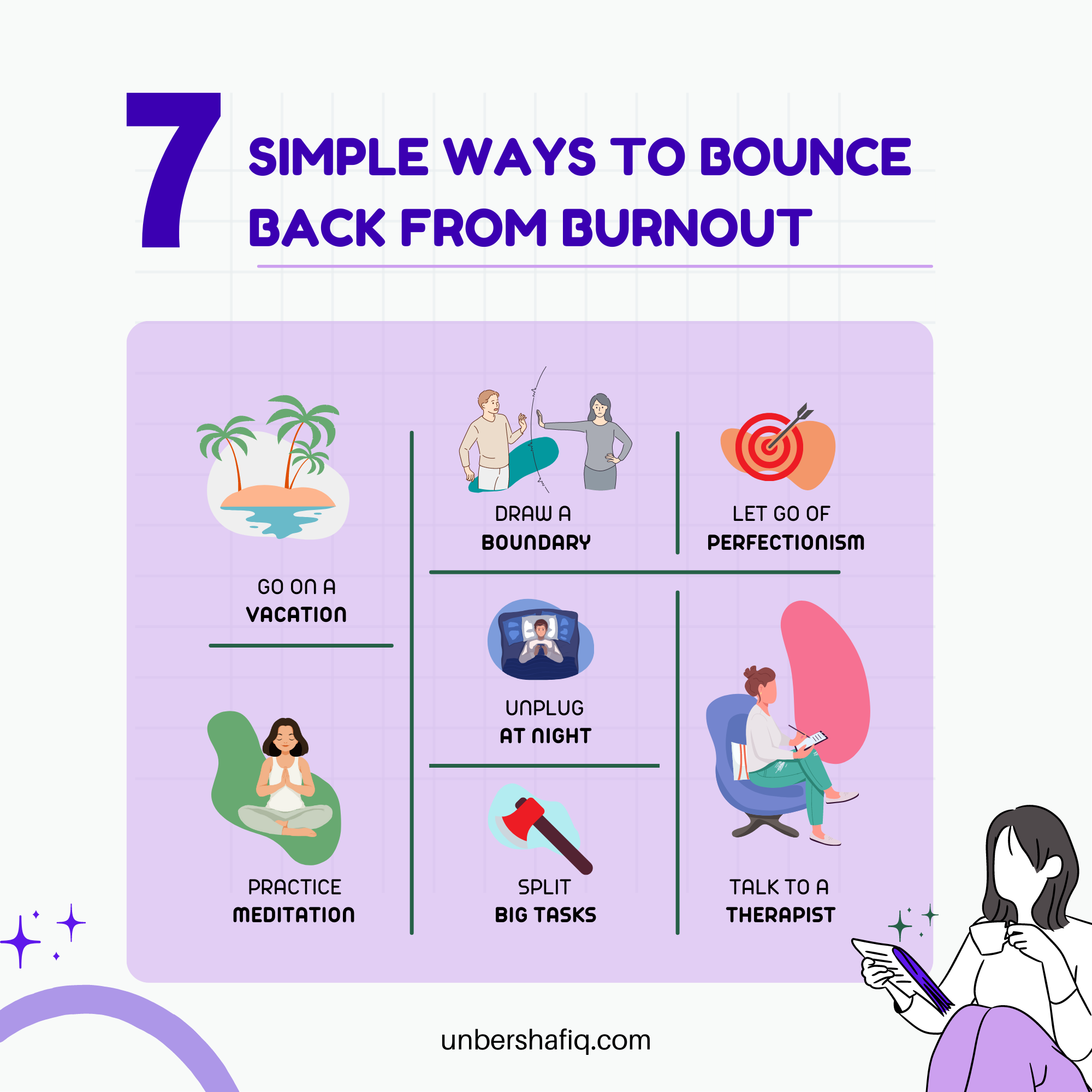
Feeling like you’re stuck in a never-ending cycle of exhaustion and low motivation? It’s time to face the possibility that you may be experiencing burnout – a common condition that affects countless individuals. According to an extensive research by Zippia, nearly 90% of workers have experienced some form of burnout in 2022. (1) You’re not alone in your struggles.
Burnout is a state of mental, emotional, and physical exhaustion that can leave you feeling drained, unmotivated, and unable to focus on your goals.
7 Surprisingly Simple Ways to Bounce Back from Burnout
I know it’s frustrating to feel like you’re not making progress. The good news is that recovery is possible with the right strategies and support. If you’re ready to get back to living your life on your own terms and start feeling like yourself again, here are some simple steps you can take to get started.
1. Escape the Grind
Taking a vacation is a proven way to tackle burnout and improve your overall well-being. Studies have shown that vacations can reduce emotional exhaustion and burnout, increase work engagement, and even boost life satisfaction and quality of life. (2, 3, 4)
The benefits of taking a break from work routine can be attributed to Attention Restoration Theory, which suggests that mental exhaustion can impair your ability to focus and regulate emotions. You could improve your cognitive functioning and reduce the risk of burnout by recharging in nature. (5)
Breaking away from the daily grind and exploring those natural wonders that look amazing on your social media could be a great addition to your burnout recovery plan.
Keep in mind that the benefits of a vacation are often short-lived, with stress and burnout levels returning to pre-vacation levels within just a few weeks. That’s why it is essential to combine your vacation with other burnout prevention strategies.
2. Take a Stand, Draw a Line
Another way to tackle burnout is by setting boundaries. I know it can be tough, but hear me out.
Better boundaries can protect you from fatigue. When you clearly communicate your limits and expectations, you prevent yourself from taking on too much work and getting overwhelmed.
Check out these 4 tips for setting boundaries that could help prevent burnout:

- Don’t be afraid to say “no” when something doesn’t align with your values or goals.
- Use assertive statements to communicate your needs, limits, and expectations respectfully. For example, instead of saying “I’m sorry, but I don’t think I can do that,” try saying “I appreciate the opportunity, but I won’t be able to take on any additional work right now.”
- Establish and reinforce your boundaries consistently, recognizing that like with children, repetition and adaptability are key.
- Respect other people’s boundaries as well. When you treat others the way you want to be treated, everyone benefits.
3. Let Go of Perfectionism
Research indicates that perfectionism is positively related to stress, burnout, and workaholism. (6) Staring at computer screens all day long and trying to turn your good work into something perfect could lead to burnout.
Next time you come across such a situation, try turning in your good work (not the perfect version you want), and you’ll see, despite that piece of work not being perfect, it’ll still be acceptable. Sometimes, we just have to finish the to-do-list and be done with our work for the day. It doesn’t always have to be perfect.
4. Practice Meditation
Meditation has a solution to almost any problem, including burnout. (7, 8) Having butterflies in your stomach before your big presentation? Feeling like a cat on hot bricks right before making your speech in front of the team members? These situations get better with simple breathing techniques of meditation.
You just have to take a deep breath, hold it for a few seconds, and then release your breath slowly. Do it a few times, and you will feel a sudden calm. If meditation yields such instant results, imagine its potential when practiced for just 30 minutes a day.
You could also try free AI-powered mental health platforms like Earkick that offer meditation sessions based on real time data. The app requires no account, no login, no ads, and it’s completely free. How awesome! Just try it out. You’d simply love it.
5. Unplug at Night
Our brains need rest at bedtime. It certainly doesn’t need more input (we already do enough of that during the day!). Sleep expert Dr. Michelle Drerup, PsyD, DBSM, explains that checking our phones at night stimulates the brain, making us more awake. The thought of the phone under the pillow or the anticipation of work email notifications triggers mental activity. Even a brief glance can delay sleep by keeping the brain engaged.
Turn off your wifi at least 1 hour before bedtime and give yourself that much needed break from screen lights. No phones! Use this hour for something you’d enjoy (no, not Netflix!); perhaps, you could try meditation, or playing with the kids, or talking to your partner.
6. Split Up Big Tasks
Managing big tasks can become overwhelming and contribute to project burnout. Consider dividing these tasks into smaller project milestones, each with its own set date.
When you have a great and difficult task, something perhaps almost impossible, if you only work a little at a time, every day a little, suddenly the work will finish itself. ~ Isak Dinesen
For any big project, try to establish clear project objectives, delegate tasks to team members, and highlight crucial deadlines. This approach helps you stay organized and prevents the negative impacts of handling extensive tasks all at once.
Adopting this strategy for larger tasks could prove super helpful in the long run. Atleast, you wouldn’t be stressed about an upcoming deadline.
7. Break the Stigma: Talk to a Therapist
Tens and millions of people need a therapist but the fear of judgment holds them back.
“What will people think if they find out I’m seeing a counselor? What if I’m spotted coming out of the office? The questions linger.
The fear of judgment and misconceptions about the reasons for seeking therapy often discourages us from reaching out for help that we truly need. But let’s break the stigma and seek therapists just like we’d seek a doctor if we break a bone.
Know that seeking therapy doesn’t imply weakness or severe illness. Instead, it’s a step towards managing life’s challenges. Speaking to a therapist about your burnout could actually be really helpful.
Still not sure?
How about you try some platform that offers online support? You could try Ginger; it offers private mental healthcare through the Ginger Emotional Support app. Users can get behavioral health coaching, video therapy & psychiatry, with evening and weekend hours, and self-guided care resources, recommended for specific needs.
Takeaway
You’re not alone – countless individuals face burnout. Empower yourself with actionable strategies: embrace breaks, set boundaries, and let go of perfectionism. Meditate for quick relief and seek therapy for long term results.